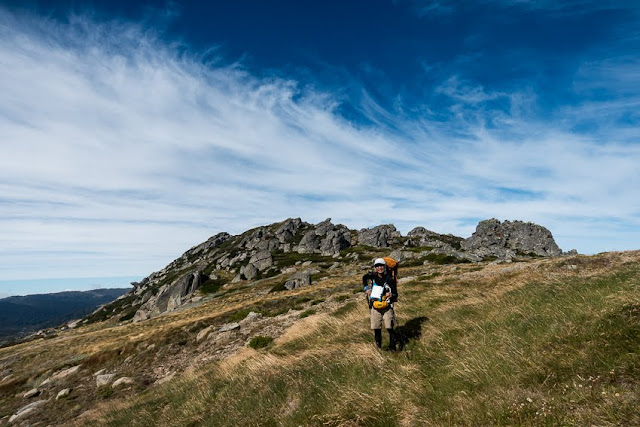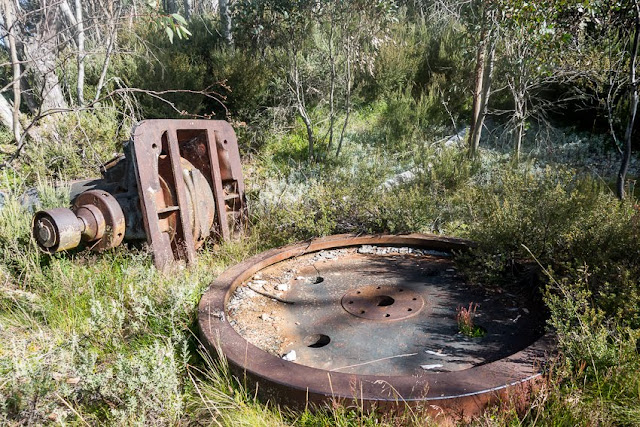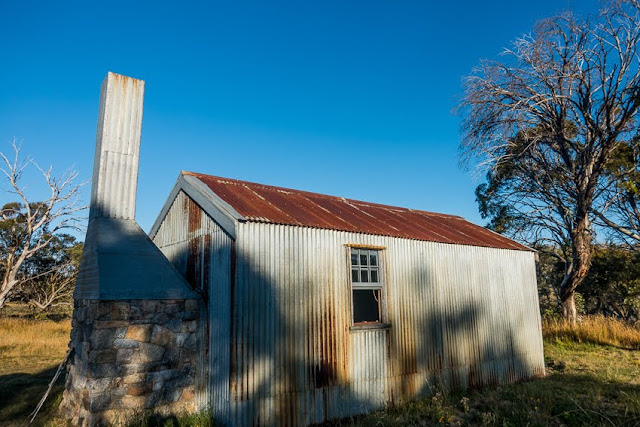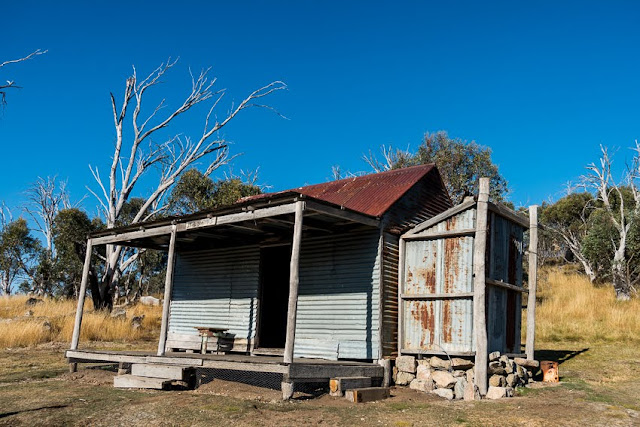One year ago we walked the last section of the Australian Alps Walking Track from
Kiandra to Tharwa. This year we walked from Dead Horse Gap to Kiandra, taking 10 days in total. The same three - my brother Matt, myself, and Iain - met up again and yes, we are planning to walk the next stage next March.
As usual I did all the trip planning, and also cooked up meals for Matt and myself for the 10 days. The precooked, dehydrated and vacuum packed meals were an outstanding success. A lot of work, but worth the effort.
Besides distributing the track notes and creating a walking itinerary, I also created GPS routes on my
InReach Satellite beacon, which we could use when navigating across untracked country, of which there was a lot on this walk. How that worked out I'll explain later, but mostly, it was a success. Yes, there were a couple of hiccups!
So, here's a day by day account of our trip, with photos of course.
Day 0: Canberra to Thredbo
Friday afternoon Matt's partner and kids drove us down to Thredbo and we all stayed the night at Thredbo YHA. This meant that we could get away early on Saturday giving us a full day of walking. The weather forecast was looking good, and it was a nice evening spent having a pub meal and watching the sun set.
Day 1: Dead Horse Gap to Wilkinson's Creek 11.8km
After breakfast Matt's family deposited us up at Dead Horse Gap and returned to Canberra. We shouldered our backpacks and headed uphill.
This starting point is off the official AAWT route, but allows for walking through the spectacular Rams Head Ranges after gaining some considerable altitude rather quickly. We all wished we had done more training beforehand, as 10 days worth of food sure makes for heavy packs! But climb we did, and soon we were above the treeline and in the spectacular rocky landscape of the NSW main range.
The trees we encountered on our way uphill were bleached dead skeletons of the Alpine Ash forests that cover the subalpine high country. It was seven days before we saw any evidence of a living forest again. The
devastating 2003 bushfires had killed all the trees, and for days all we saw were the ghostly remains of these vast forests.
Once on the main range, we navigated across the Rams Head Ranges to join the main route to Mt Kosciuszko, Australia's tallest mountain. We used my InReach to monitor our route but mostly we just used maps and visual landmarks. Visibility was superb, without a cloud in the sky, so the biggest challenge was sun protection. Soon after lunch we spied the main track from the Thredbo chairlift snaking its way towards Kosciuszko, complete with many day trippers, and we too joined the track for the final couple of kilometres.
Kosckiusko, at 2228m ASL, is a rather uninspiring peak. It has a round top that is less than imposing in a landscape dotted with spectacular granite bouldered peaks. The track up is an easy stroll, watched over by a murder of crows that wheel around you as you pass, evoking the spooky feeling of being in a Hitchcock film! There's even a public toilet just below the summit at Rawson's Pass.
Leaving the daytrippers behind, we headed north to Wilkinson's Creek for our overnight camp. At least three other groups of walkers also camped there overnight, but there was lots of room for all of us to camp good distances from each other, and enjoy a spectacular sunset.
Day 2: Wilkinson's Creek to Anton Anderson Saddle 19.5km
A relatively warm and still night saw us up and away with dry tents by 9am. First we made our way up to the Mt Townsend track, just above our campsite, where we dumped our packs and walked the 2 hour return trip up to the summit of Australia's second highest peak. This one required a little rock scrambling, and physically is a much more impressive looking mountain than it's slightly taller cousin over the valley.
Back on the main track we continued north to the junction with the Blue Lake track. From here the rest of the main range walk is on the unofficial AAWT, so before heading further on we again dumped the packs to see the spectacular glacial lake. We also met John, another AAWT walker, on a much tighter schedule than us.
From the junction with the Blue Lake/Charlottes Pass track, the path over the main range became more of a footpad than a decent wide track, but was still readily visible and easy to follow. The wind was pretty strong, but it wasn't cold thankfully. We caught up with John at Mt Twynam, which we climbed, and then all four of us continued to Anton Anderson Saddle where we camped near a watercourse. There had been some concern that water might be a problem on the main range, as the summer has been unusually dry, but we were always able to find a good supply at all our campsites.
Day 3 Anton Anderson Saddle to Whites River Hut 10.7km
Today we needed to use my InReach to find our way, as the track along the main range at last petered out. Even with good visibility there were many granite peaks and identifying what was what was somewhat difficult. Iain also has an InReach, and was not aware you could load predetermined routes on the device beforehand, so was interested to see how it performed.
The route involved staying on the main range until Consett Stephen Pass where we crossed over onto the next range known as The Rolling Grounds. This range is a boggy, granite strewn landscape, but luckily the dry weather made the going quite easy across ground that would normally have been anything from damp to plain muddy.
At some point we needed to head down to Whites River Hut, and this entailed a difficult scramble downhill through thick scrub before finding a track down to the Hut. We decided to call it a day at 3pm, and farewelled John who headed on in his quest to get to Tharwa by the 13th March.
As the evening approached, so did a thick mist, which we hoped would clear for our next day across more untracked high country...
Day 4 Whites River Hut to Valentine Hut 12.9km
We woke to a thick mist all around, but it seemed to be lifting, so we decided to stick with our original plan to head up Mt Gungarten and over The Kerries to Mawson's Hut. We packed up and headed up to Schlink Pass, where the route began.
I had mapped this route before leaving, as there was no track. We found the starting point for the walk up the ridge marked by a cairn which matched my InReach route but by the time we climbed up a few hundred metres our ability to use visual landmarks was obscured by waves of low cloud and mist. It was cold and windy, and thoroughly unpleasant.
We made our way up through the heavy scrub to just below the summit of Gungarten. My InReach route didn't seem to fit the landscape we should have been going through, the wind was howling, we had all our warm clothes on, and we couldn't see more than a few metres ahead of us. The thick fog came in and out, so we hunkered down out of the wind, made ourselves a pot of tea, and waited to see if the weather would clear.
The weather didn't clear much within the hour, so we made the decision to come down from the high country and continue on the official AAWT route following the fire trails. Once we dropped down into the treeline again the wind dropped, the temperature soared, and the sun came out. We could see that the weather was still wild up top, so we knew we had made the right decision.
It turned out I had not mapped the route up Gungarten correctly, which explained why my route didn't fit with the landscape we were in. This hadn't helped our situation at all, and I resolved that next trip all three of us would sit down beforehand and agree on the mapped route well ahead of the day. When the route is correct, the InReach tracks it perfectly, as we found out later in the trip.
Once back on the fire trail we made good time as the walking was easy. We stopped for lunch at Schlink Hilton Hut, then turned on to the Valentine trail to finish our day's journey at Valentine Hut. This little Tardis of a hut is a real gem. Matt and I both slept in the hut overnight, and we had a nice warm fire going in the stove as well.
Day 5: Valentine Hut to Grey Mare Hut 9.5km
First thing in the morning we headed down the Valentine River to see Valentine Falls. The track was dreadfully overgrown and in the end we were unable to find our way down to the bottom of the falls. Perhaps with more time on our hands we could have persisted.
Back at the hut we donned our packs and took the fire trail route, a much easier walk with packs than the shorter route via the falls, to Grey Mare Hut. We arrived late afternoon at the hut, dropped our bags and went to investigate all the old mine relics behind the hut.
Half an hour later we returned to the hut to find a group of eight walkers from Melbourne had arrived and commandeered the entire area, pitching their tents in all the best spots and taking over the hut as well. Not to mention stripping naked in the middle of the track to have showers right next to the water collection spot. Nice enough as individuals, collectively they were a very inconsiderate group of bushwalkers, even taking over the outside campfire in the morning (which we were using as they had taken over the hut) and burning all their rubbish, including plastic, in the fire!! We were glad to hear they were walking a different route to us.
Day 6: Grey Mare Hut to Tumut River 17.5km
After waking to a morning frost we gave the Melbourne crew a good hour before we also headed off. The walking was quite easy along fire trails, the weather remained sunny and warm, and the trees were still just bleached and dead. We stopped in at Dershkos Hut before setting up camp on the Tumut River at the base of Mt Jagungal.
The Tumut River begins here so it's only an insubstantial stream, and not a lovely tree lined waterway, so we had to jig up our own shade using a ponchotarp whilst we had lunch and waited a couple of hours for the heat of the day to lessen.
Unfortunately it didn't, so a little before 3pm we headed up the track to the summit of Mt Jagungal. It's an imposing sight in the landscape, and the views from the top are expansive. We could see the Kerries and all the terrain we had been unable to traverse due to bad weather and I was secretly glad we had not been above the treeline for all those days as the weather has been very hot and we are all just a bit sunburnt.
Back at camp we lost the sun early as we are in a deep valley, and we were soon all in bed to keep warm.
Day 7: Tumut River to Mackays Hut 14.3km
We woke to a thick frost and freezing conditions, and had to wait some time for the sun to clear Jagungal and begin to warm us up. The tents got packed wet and we headed around the base of Jagungal to O'Keefe's Hut. An unassuming tin hut from the outside, a wealth of character on the inside, complete with old newspapers lining the walls, a french polished dining table, and beautifully crafted wooden benches. The
Kosciuszko Hut Association looks after all these high country huts in collaboration with the National Parks and Wildlife Service and I am inspired to join them, if only to give them some financial aid for the great job they do.
We decided to have a long lunch at O'Keefe's and read the newspapers, as the hut logbook indicated we would be sharing our campsite with another group of bushwalkers also walking the AAWT on the same itinerary as us. We didn't have a huge distance to cover to Mackays, so we took our time.
The walk was easy, following fire trails over undulating easy terrain. Still not much in the way of living forest, so not much shade to speak of. Before long we were at Mackays Hut, perched on a hill looking out on the plain below.
A group of six from the Adelaide Bushwalkers were walking the AAWT from Dead Horse Gap to Tharwa, having completed the Victorian sections in 2017. They had come over the Kerries a day later than our attempt, in much better weather, but said the going had been very rough through trackless country. As a group they had spread out a bit in the campsite and hut, but they hadn't known we were coming, and in the subsequent days that we shared the same campsites, they showed consideration and we all got on well. Quite different from the Melbourne group!
Day 8: Mackays Hut to Happy's Hut 17.5km
We gave the Adelaide group an hour head start and walked briskly for a little over 2 hours before stopping for lunch under some shady trees and taking a good long rest before walking another two and half hours to Happy's Hut. We aren't clocking up huge distances each day and there's no point spending most of the day at the hut, so we've started to have middle of the day siestas. We are all feeling very relaxed…
Happy's Hut was lucky to survive the devastating 2003 bushfires, saved by a determined helicopter pilot who water bombed it just in time.
At sunset a lone cyclist turns up, but otherwise it's just us and the ABW group.
Day 9 Happy's Hut to 4 Mile Hut 19.2km
The Adelaide mob were planning not to do the scrub bashing shortcut up the hill from Happy's after reading an adverse report in one of the hut books. The alternative is a 6km loop, but after hearing we were doing it, they decided to also. We gave them a half hour head start, then we too tackled the route.
I was pretty sure I had mapped this route accurately, as it was merely a bearing of due north from the hut that would intersect with the Tabletop Mountain trail at the top of the hill. The landscape was heavily treed with no visual references, so the only way to navigate was with a compass or GPS.
The trail left the hut, crossed the stream, then petered out. We took turns bashing through the scrub lower down before winding our way up the ridge following the bearing as per the InReach. The undergrowth thinned out higher up, and we intersected the track bang on where we were supposed to be.
Back on the main track we made our way towards Tabletop Mountain where we again used the beacon bearing to determine which direction to take up to the summit. The views from the top way back to Jagungal and beyond were impressive, as were the muted blues of the many ridges to the north. Back down we had lunch, then headed on to detour again to Broken Dam Hut. This hut was burnt down in the 2003 fires and completely rebuilt in 2009. It's a very pretty hut, but lacks character. There's also no water nearby.
The day is a scorcher, and we are going through a lot of water. Luckily there are enough creeks crossing the trail to replenish supplies. At last we reach the 4 Mile Hut turnoff and head across a valley, over a stream, and through a piece of unburnt forest, to the extremely quaint and original 4 Mile Hut. An old miner's hut made of wood slabs and kerosene tins, it was fortuitously saved by a backburn before the 2003 fire got there. It sure is a beauty to end our trip on.
Our Adelaide friends are there, as are a group of Scouts from Canberra. Iain somehow manages to hoodwink the kids into erecting his tent, collecting firewood, and even starting the fire. They are a good bunch of kids enjoying the outdoors and we all sit around for a while chatting and sharing stories.
Day 10: 4 Mile Hut to Kiandra 7.5km
We are again last to leave, but catch up with the Adelaide walkers a kilometre or so before Kiandra. They are staying a couple of nights at Wolgal Hut, a NPWS Hut at Kiandra which is available to rent. It is a pretty luxurious prospect after camping for over a week! Ben even cracks open his large supply of boutique beers for us to sample.
After a little beer tasting and chatter, we farewell our Adelaide walking friends, and head up to the old courthouse to meet up with Sandra, Iain's wife, for the return trip to Canberra. More cold beer consumed, and a tasty burger in Adaminaby, then it's home to a hot shower and a soft bed.
We have been warned that the Victorian part of the AAWT is much tougher. A lot more ups and downs, and some difficulties finding the track. We shall have to be even more prepared for the next bit.
We have a year….
 Back in New Zealand I loaded all my camping gear in a bag and schlepped over to Small Planet in Queenstown to try on a few of their Aarn packs. My method of buying a new pack is to always try it out with the actual gear I'll be packing in to it. Not only to check it out for weight and comfort, but to see how the pack works with storing the gear itself. Although I had done a lot of the research online, nothing compares with trying out the packs in person. In fact the pack I had my eye on ended up not being what I wanted as it had no external pockets on the main pack at all, and I didn't like how the front pockets attached to the waist belt.
Back in New Zealand I loaded all my camping gear in a bag and schlepped over to Small Planet in Queenstown to try on a few of their Aarn packs. My method of buying a new pack is to always try it out with the actual gear I'll be packing in to it. Not only to check it out for weight and comfort, but to see how the pack works with storing the gear itself. Although I had done a lot of the research online, nothing compares with trying out the packs in person. In fact the pack I had my eye on ended up not being what I wanted as it had no external pockets on the main pack at all, and I didn't like how the front pockets attached to the waist belt.  In the end, I purchased the Peak Aspiration with Sport Balance Pockets. The main pack is 44L and the pockets add another 12L. It has integrated waterproof liners in all the bags, and the side straps allow me to carry skis should I decide to go ski touring this winter.
In the end, I purchased the Peak Aspiration with Sport Balance Pockets. The main pack is 44L and the pockets add another 12L. It has integrated waterproof liners in all the bags, and the side straps allow me to carry skis should I decide to go ski touring this winter.















































































































